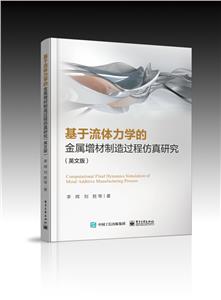-
>
湖南省志(1978-2002)?铁路志
-
>
公路车宝典(ZINN的公路车维修与保养秘籍)
-
>
晶体管电路设计(下)
-
>
基于个性化设计策略的智能交通系统关键技术
-
>
德国克虏伯与晚清火:贸易与仿制模式下的技术转移
-
>
花样百出:贵州少数民族图案填色
-
>
识木:全球220种木材图鉴
基于流体力学的金属增材制造过程仿真研究 版权信息
- ISBN:9787121406140
- 条形码:9787121406140 ; 978-7-121-40614-0
- 装帧:一般胶版纸
- 册数:暂无
- 重量:暂无
- 所属分类:>
基于流体力学的金属增材制造过程仿真研究 本书特色
本书针对金属增材制造加工过程进行了系统研究,基于计算流体动力学方法研究金属增材制造工艺过程中的流体问题。**章为绪论。第二章至第四章研究金属增材制造打印机腔体内部流场及颗粒分布特性,并设计了新颖的流体罩和负压管对打印机腔体内部流场优化以及溅射颗粒清除。第五章至第九章主要研究金属增材制造加工过程中熔池特性,其中第五章研究了金属熔池动力学特性,第六章研究了外加磁场对金属增材制造过程中熔池以及凝固过程的影响,第七章和第八章研究了金属增材制造过程中工件内部单气孔缺陷和多气孔缺陷的演化过程。第九章研究了外部流场对金属增材制造过程中工件内部气孔缺陷演化过程的影响。第十章研究金属增材制造工件激光清洗工艺,以控制工件表面粗糙度。
基于流体力学的金属增材制造过程仿真研究 内容简介
本书针对金属增材制造加工过程进行系统研究,基于计算流体动力学方法研究金属增材制造工艺过程中的流体问题。章为绪论。第2~4章研究金属增材制造打印机腔体内部流场及颗粒分布特性,并设计新颖的流体罩和负压管分别对打印机腔体内部流场进行优化及溅射颗粒清除。第5~9章主要研究金属增材制造加工过程中熔池特性,其中,第5章研究金属熔池动力学特性,第6章研究外加磁场对金属增材制造过程中熔池及凝固过程的影响,第7章和第8章研究金属增材制造过程中工件内部单气孔缺陷和多气孔缺陷的演化过程。第9章研究金属增材制造工件激光清洗工艺,以控制工件表面粗糙度。本书内容系统全面,新颖独特,面向从事增材制造和激光加工等相关领域的科研人员,以及关注优选制造、智能制造的专家学者和普通读者。
基于流体力学的金属增材制造过程仿真研究 目录
1.1 Background 2
1.2 Motivation 3
1.3 Outline 4
Chapter 2 Investigation of the flow field in Laser-based Powder Bed Fusion
manufacturing 5
2.1 Introduction 7
2.2 Simulation model of the L-PBF printer 10
2.2.1 Problem description 10
2.2.2 Geometric model of the L-PBF printer 11
2.2.3 Numerical model of the L-PBF printer 12
2.3 Simulation results 16
2.3.1 Distribution of the flow field 16
2.3.2 Distribution of the temperature field 21
2.3.3 Distribution of spatter particles 23
2.4 Conclusions 28
References 30
Chapter 3 Investigation of optimizing the flow field with fluid cover in
Laser-based Powder Bed Fusion manufacturing process 33
3.1 Introduction 35
3.2 Simulation model of L-PBF printer 37
3.2.1 Geometry of L-PBF printer with a fluid stabilizing cover 37
3.2.2 Numerical model of printer with a fluid stabilizing cover 37
3.2.3 Mesh of L-PBF printer with a fluid stabilizing cover 39
3.2.4 Model of the fluid stabilizing cover and particles 40
3.3 Simulation results and discussion 43
3.3.1 Influence of the fluid stabilizing cover on the flow field 43
3.3.2 Influence of fluid stabilizing cover on particle distribution and removing rate 47
3.4 Summary and conclusions 51
References 53
Chapter 4 Numerical investigation of controlling spatters with negative pressure
pipe in Laser-based Powder Bed Fusion process 54
4.1 Introduction 56
4.2 Simulation model of L-PBF printer 59
4.2.1 Geometric model of L-PBF printer 59
4.2.2 Numerical model of L-PBF printer 61
4.3 Simulation results and discussions 64
4.3.1 Effect of pipe diameter 68
4.3.2 Effect of outlet flow rate 70
4.3.3 Effect of initial particle velocity 74
4.4 Summary and conclusions 76
References 78
Chapter 5 Evolution of molten pool during Laser-based Powder Bed Fusion of
Ti-6Al-4V 80
5.1 Introduction 82
5.2 Modeling approach and numerical simulation 85
5.2.1 Model establishing and assumptions 85
5.2.2 Governing equations 87
5.2.3 Heat source model 87
5.2.4 Phase change 88
5.2.5 Boundary conditions setup 89
5.2.6 Mesh generation 90
5.3 Experimental procedures 91
5.4 Results and discussions 92
5.4.1 Surface temperature distribution and morphology 92
5.4.2 Formation and solidification of the molten pool 94
5.4.3 Development of the evaporation region 98
5.5 Conclusions 101
References 103
Chapter 6 Simulation of surface deformation control during Laser-based
Powder Bed Fusion Al-Si-10Mg powder using an external magnetic field 107
6.1 Introduction 109
6.2 Modeling and simulation 112
6.2.1 Modeling of L-PBF 112
6.2.2 Mesh model and basic assumptions 113
6.2.3 Heat transfer conditions 114
6.2.4 Marangoni convection 115
6.2.5 Phase-change material 115
6.2.6 Lorentz force 116
6.3 Results 118
6.3.1 Velocity field in the molten pool 118
6.3.2 Lorentz force in the MP 121
6.3.3 Surface deformation of the sample 123
6.4 Conclusions 127
References 128
Chapter 7 Influence of laser post- processing on pore evolution of Ti-6Al-4V
alloy by Laser-based Powder Bed Fusion 131
7.1 Introduction 133
7.2 Experimental procedures 136
7.2.1 Sample fabrication 136
7.2.2 Determination of porosity by micro-CT 137
7.3 Modeling and simulation 140
7.3.1 Numerical model 140
7.3.2 Moving Gaussian heat source 143
7.3.3 Thermal boundary conditions 143
7.3.4 Marangoni effect, surface tension and recoil pressure 144
7.4 Numerical results and discussion 145
7.5 Conclusions 152
References 153
Chapter 8 Evolution of multi pores in Ti-6Al-4V/Al-Si-10Mg alloy during laser
post-processing 157
8.1 Introduction 159
8.2 Experimental procedures 162
8.2.1 Sample preparation 162
8.2.2 Detection of porosity by mirco-CT 162
8.3 Model and simulation 165
8.3.1 Simulation model 165
8.3.2 Gaussian heat source 167
8.3.3 Latent heat of phase change 168
8.3.4 Level-set method 169
8.3.5 Boundary conditions 169
8.4 Numerical results and discussion 171
8.5 Conclusions 177
References 179
Chapter 9 Investigation of laser polishing of four Laser-based Powder Bed
Fusion alloy samples 182
9.1 Introduction 184
9.2 Model and theoretical calculation 188
9.2.1 Physical model and assumptions 188
9.2.2 Governing equations and boundary conditions 190
9.2.3 Simulation results 192
9.3 Experimental methods 195
9.3.1 Sample fabrication 195
9.3.2 Morphology observation by 3D optical profiler 198
9.3.3 Experimental results 199
9.4 Conclusions 206
References 208
基于流体力学的金属增材制造过程仿真研究 作者简介
李辉,中共党员,教授、博导,湖北省特聘专家,***"青年****”入选者,国家重点研发计划项目首席科学家,IEEE高级会员。于1995年至2002年就读于华中科技大学机械科学与工程学院,获得工学学士与硕士学位。作者于2002年获得新加坡科研局博士奖学金,在新加坡国立大学(NUS)电子与计算机系和新加坡数据存储研究所(DSI)进行博士学位的联合培养,师从于新加坡数据存储研究所高级研究科学家(Senior research scientist)刘波博士(国家"****”特聘专家,教育部长江学者讲座教授)和新加坡国立大学电子与计算机工程系教授Chong Tow Chong(现任新加坡理工大学(SUTD)校长),并于2007年获得工学博士学位。作者于2008年进入美国加州大学圣地亚哥分校(UCSD)从事博士后研究,师从于UCSD机械和科学工程学院前主席、磁记录中心首席教授Frank E. Talke院士。作者于2005年至2013年就职于日立公司(Hitachi)亚洲研究与发展中心,其中于2006年在日立总部中央研究所交流半年,2008年起担任研发中心项目领导及副经理。在新加坡、日本和美国长达11年的学习和科研工作经历,主攻磁记录硬盘可靠性研究,实现微机电系统的高精度定位控制设计和应用。作者主持完成与美国美国加州大学圣地亚哥分校,新加坡数据存储研究所和日立日本本部的联合科研项目7项。作者2012年入选国际电器与电子工程师学会(IEEE)高级会员,2013年入选***"青年****”,获聘为武汉大学教授、博士生导师,2014年被授予湖北省特聘专家称号。作者主要从事先进制造工艺过程、在线监测及产品可靠性等研究,发表SCI期刊论文80余篇、国际会议论文60余篇,在美国、新加坡、韩国做特邀报告4次。主编英文专著2部、中文专著1部,获国家科学技术学术著作出版基金资助1次。提交/授权国家发明专利41项、授权软件著作权3项。作者承担科研项目包括国家自然科学基金委重大科研仪器研制项目(教育部唯一推荐)、国家重点研发计划"增材制造与激光制造”重点专项、国家重点研发计划"网络协同制造和智能工厂”重点专项(首席)、JKW基础加强项目、湖北省技术创新专项(重大项目)、广东省重点领域研发计划、四川省重点研发计划、广东省科技创新战略专项资金自由申请项目、深圳市基础研究计划项目、深圳市协同创新计划国际合作研究项目、华为公司技术咨询报告等。
- >
推拿
推拿
¥12.2¥32.0 - >
自卑与超越
自卑与超越
¥12.7¥39.8 - >
名家带你读鲁迅:朝花夕拾
名家带你读鲁迅:朝花夕拾
¥10.5¥21.0 - >
回忆爱玛侬
回忆爱玛侬
¥23.0¥32.8 - >
中国人在乌苏里边疆区:历史与人类学概述
中国人在乌苏里边疆区:历史与人类学概述
¥34.1¥48.0 - >
二体千字文
二体千字文
¥22.4¥40.0 - >
龙榆生:词曲概论/大家小书
龙榆生:词曲概论/大家小书
¥13.0¥24.0 - >
上帝之肋:男人的真实旅程
上帝之肋:男人的真实旅程
¥19.3¥35.0
-
机械电子工程设计
¥14¥29 -
阀门设计技术选编
¥80¥100 -
现代制造技术
¥30¥43 -
普通高等教育“十一五”国家级规划教材:轮机自动化
¥16.4¥38 -
液压维修1000问第2版
¥133.5¥169 -
利维坦的道德困境:早期现代政治哲学的问题与脉络
¥36.3¥49





















